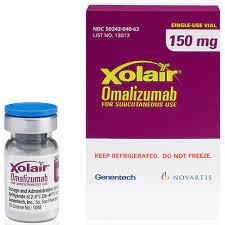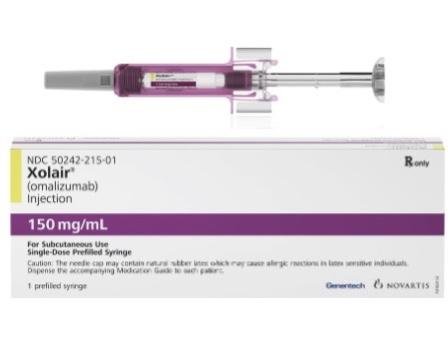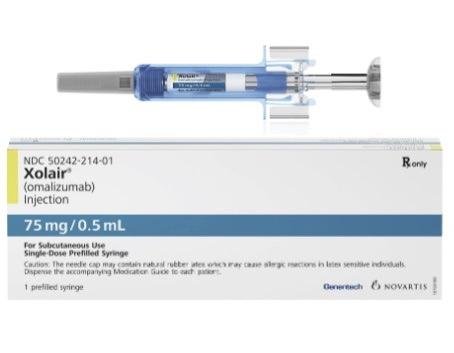
What is Xolair?
The Xolair (omalizumab) injection is a medicine that is used to treat various forms of allergy, asthma, nasal polyps, and chronic hives (chronic spontaneous urticaria). Xolair is effective by reducing the release of inflammatory chemicals that cause allergies, which in turn reduces immune responses within the body.
Xolair is an antibody monoclonal that is generally administered every 2 to 4 weeks to sustain its therapeutic properties.
What exactly does Xolair do?
If you are suffering from allergies, your overactive immune system creates antibodies known as immunoglobulin E (IgE) that attach to receptors on cells and trigger the release of chemical compounds like histamine, which trigger allergy symptoms. Xolair acts by preventing the binding process of IgE to cell receptors, which blocks the release of chemicals that cause allergic symptoms. Xolair also decreases the amount of IgE receptors in cells, leading to the improvement of symptoms associated with allergies.
What exactly is Xolair used to do?
Xolair is FDA-approved for treating:
- Moderate-to-severe asthma that can be caused by allergies in children and adults who are six years of age or older. It can be prescribed when asthma symptoms aren't controlled by asthma-inhaled steroid medications. The product is not considered a remedy for treating asthma attacks in an emergency.
- Chronic hives (idiopathic urticaria) in children and adults that are 12 years old when antihistamine medications have been tested but did not work. It is not recommended to use it to treat other types of hives.
- Nasal polyps for people who are aged 18 and older, as an added-on medication in cases where nasal corticosteroids do not work well.
Warnings
Some individuals who use this injection have experienced severe allergic reactions, potentially life-threatening, within the first few hours. The allergic reaction can happen even after regular use of this injection for up to a year.
Take immediate medical care. If you notice any indications or symptoms of an allergic reaction, Xolair symptoms include an itch, hives, anxiety, or flushing (warmth redness or a tingly sensation), feeling like you're going to pass out and the chest is tight, wheezing, feeling breathless, or breathing difficulties; fast or weak heartbeats; and swelling of your lips, face, and throat.Asthma is typically treated with a mixture of various medications. Take all medications as instructed by your physician. Take note of the medication guide or patient's instructions that come with every medication. Don't alter your doses or schedule of medication without your physician's approval.
If you also take an oral steroid medication, make sure you don't stop taking the steroid abruptly, or you could suffer from painful withdrawal signs. Consult your physician if any of your asthma medications do not seem to be effective in preventing or treating attacks. It is possible that your symptoms will not get better immediately after you begin receiving Xolair. For the best results, you should continue taking the injections as directed. Discuss this with your physician in the event that your symptoms don't improve after several days of treatments.Make sure to use Xolair often to reap the maximum benefits. Make sure you refill your prescription before you run out of medication completely.
Similar/related drugs
Cetirizine, Loratadine, Benadryl, Diphenhydramine, Promethazine, Zyrtec, and Symbicort
Before you take this drug
It is not recommended to take this medication if you are allergic to omalizumab or any other inactive components. Click here to view a complete listing of the ingredients.
To ensure that Xolair is appropriate for you, ask your doctor if you suffer from:
- Any indication of any signs of (fever, swelling glands, fever, or general feeling of ill-health)
- Other allergies (foods such as pollen, food items, etc.)
- An infection caused by parasites (such as malaria, giardia leishmaniasis, hookworm, pinworm, toxoplasmosis, and a myriad of others)
- Cancer that has occurred in the past or is currently present
- A previous history of heart attack or stroke
- If you're receiving allergy shots
- If you've ever experienced an extremely severe allergy (anaphylaxis),
- If you suffer from an allergy to latex, since the cap that holds the needle on the prefilled syringe is made of natural rubber latex,
The injection you receive could increase the risk of certain kinds of cancer that affect the skin, breast, prostate, or salivary gland. Discuss with your physician the risks you face based on your personal situation.When you're taking this medication, you could have a higher possibility of getting infected by parasites (worms) when you live in areas or travel to places in which such infections are prevalent. Discuss with your physician the signs to look out for and the best way to manage this issue.
Pregnancy
Inform your doctor if you are expecting or planning to become pregnant while receiving treatment. If you become pregnant during this injection, consult your doctor.If you're expecting and you are a registered mother, your name could be included on the pregnancy registry. This will help track the progress of your pregnancy and assess any negative effects on the baby's development.
Breastfeeding
It's not clear if the Xolair medication could cause harm to the nursing baby. Inform your doctor if you are planning to or are nursing. feed a baby.
How to take Xolair?
Before you begin treatment with this medication, Your doctor will run an allergy test on your skin or a blood test to be certain that this medication is suitable for you.
Xolair is administered by injection into the skin (subcutaneous injection). When you first begin your treatment, the injection is administered by your doctor.You will be closely monitored for a brief period after having the injection to ensure that you don't suffer an allergic reaction to the drug.
Your physician may decide that the injections are given by you or your caregivIn this case, you will receive instructions on how to prepare and inject the medication. Don't attempt to use Xolair until you've been instructed on how to use the syringe-prefilled injections.For children 12 years of age and older, the prefilled syringe can be self-injected with adult supervision. For children aged 6–11 years old, the syringe prefilled with a needle is to be administered by a parent.
Xolair is typically administered every 2 or 4 weeks, depending on the type of condition you're treating.
It is possible to treat the condition by combining medications. Take all medications as instructed by your physician. Review the medication guideline or patient's directions that are included with every medication. Don't change your dosages or your medication schedule without a physician's guidance.If you also take a steroid medication, take care not to stop taking it abruptly, or you may experience uncomfortable withdrawal symptoms. Discuss with your doctor if the asthma medication you are taking does not appear to be working equally well for stopping or treating attacks.
When you are taking this medication, it is possible that you will require regular medical tests, like allergy tests or tests for lung function. Also, your stools might need to be screened for parasites, particularly in the event that you travel.The condition you are experiencing may not improve in the immediate timeframe. For the best results, you should continue taking the prescribed medication. Discuss this with your physician in the event that your symptoms don't improve after several days of medication.
Xolair The prefilled syringe instructions are:
- The carton that contains the prefilled syringe from the refrigerator Put the carton in storage for at most 15 to 30 minutes to allow the prefilled syringe time to get warm to the temperature of the room. Place the syringe that has been filled inside the carton to protect it from sunlight.
- Don't speed up the process of warming by using heating sources such as warm water or microwaves.
- Examine the contents of the prefilled syringe for discoloration and particulate matter prior to administering. The solution should not be transparent and colourless, ranging from light rownish-yellow to dark brown. Don't use the syringe that has been prefilled in the event that the solution is discoloured, cloudy, or has particles.
- Make sure you have the right number of prefilled syringes to meet the patient's dosage.
- If patients require more than one injection for a complete dosage, give each injection at least one inch from the injection site.
- Utilise the injection within four hours of removing it from the refrigerator.
- Inject subcutaneously into the abdomen or thigh and avoid the 2 inches (5 cm) area that is directly between the navel. The outer part of the upper arms can be utilised only if the injection is administered by a carer or medical professional. The injection could take between 5 and 10 minutes to administer.
- The syringe you used to dispose of is in a container that is puncture-resistant. Discuss with your doctor or pharmacist how you can dispose of this container with puncture resistance.
For additional directions, including diagrams for all Xolair devices and instructions on how to inject,
Details on dosage
Usual Adult and Paediatric Doses for Asthma:
Dose The dosage ranges from Xolair 75 mg to 375 mg subcutaneous injections every 2 or 4 weeks. The dosage and frequency of injections are based on the weight of the patient and their pre-treatment IgE levels. Click here for "Detailed Xolair Dosage Information" for more information on doses.
Comments:
- Interruptions that last less than one year: The dose is based on the serum ige levels at the time of the dose assessment.
- Interruptions lasting one or more years: Retest the total serum ige levels to determine the dose.
- Regularly review the need for continuing therapy based on the degree of disease and the level of control over asthma.
Utilisation: Management of moderate to severe persistent asthma patients (12 years old and over) who aren't adequately treated with corticosteroids inhaled and by a positive skin test as well as in vitro reactions to an aeroallergen that is a constant source of
Normal Adult Dose to Treat Chronic Rhinosinusitis that is Accompanied by Nasal Polyps (CRSwNP)Dose between 75 and 600 mg subcutaneously every 2 to 4 weeks. The frequency and dose of the injections are determined by the weight of the patient and their pre-treatment IgE levels. Click here for "Detailed Xolair Dosage Information" for more information about doses.
Comments:
- Re-evaluate the need for ongoing therapy based on the severity of the disease and degree of symptom control.
- Interruptions that last less than one year: The dose is based on the serum ige levels at the time of the initial dose determination.
- Interruptions lasting one calendar year and more Test the total serum ige levels to determine the dose.
Utilisation: As an add-on maintenance treatment for chronic rhinosinusitis accompanied by nasal polyps (CRSwNP) for adults who are 18 years old or older who have a poor response to nasal corticosteroids.
Usual Adult Dose for Chronic Spontaneous Urticaria (CSU):
Dosage: 150mg or 300 mg subcutaneously once every four weeks.
Comments:
- Dosing is not contingent upon IgE concentrations or the body's weight.
- Do not administer more than 150 mg at each injection site.
- The optimal time for therapy for CSU is not yet determined. Reassess regularly the need for ongoing therapy.
Usage: chronic idiopathic urticaria with patients who are still symptomatic after H1 antihistamine therapy.
Xolair is available in the form of:
- Xolair single-dose prefilled syringe: 75 mg/0.5 millilitres (blue needle shield).
- Xolair single-dose prefilled syringe, 150 mg/mL (purple needle shield).
- Xolair one-dose bottle: 150 mg to reconstitute
What happens if I miss a dose?
Contact your doctor for advice. If you do not show up to get your injection,
What happens if I overdose?
For medical emergencies, seek emergency medical attention or contact the Poison Help line toll-free at 1-800-222-1222.
Side effects of Xolair
Certain people who take the Xolair medication have experienced a severe, life-threatening allergic reaction immediately following the injection or a few hours later. The allergic reaction can occur after taking the drug regularly for at least a year.
Seek medical attention immediately. If you notice any indications that indicate an allergy reaction to Xolair:
- Hives, itching;
- Worry or fear, the feeling that you could be ill;
- Flushing (warmth of redness or tingly sensation);
- The chest is tight; there's a wheeze, cough, and feeling out of breath; difficulty breathing;
- Rapid or weak heartbeats
- Swelling of your lips, tongue, or face.
See your doctor right away. If you suffer from:
- Continuous nausea or vomiting; severe or watery diarrhoea
- Trouble breathing
- Numbness or tingling sensations in your legs or arms;
- Muscles, fever, and rash that appear within a few days of receiving an injection
- Indications for an ear infection: ear pain, fever or fullness, difficulty hearing, drainage from the ear or ear, and crying in children;
- Symptoms of a heart attack: chest pain or pressure, pain that is spreading to your shoulder or jaw,
- Symptoms of a blood clot, such as sudden weakness or numbness in vision, problems with speech, a coughing up of blood, swelling, or redness in the leg or arm.
Common Xolair adverse effects could include:
- Rash;
- Fever;
- Nosebleeds;
- Joint pain, bone fractures;
- Leg or arm injury;
- Nausea, vomiting, diarrhea, and stomach pain;
- Headache;
- Nausea, fatigue;
- Infections, earaches;
- Swelling, pain, bruising, or irritation in the area at the site of the injection of the medicine
- Cold symptoms like nasal stuffiness, sneezing, coughing, sinus pain, and a sore throat.
This is not a comprehensive list of possible side effects, and other effects may also be present. Consult your physician for advice regarding medical effects. You can report any adverse reactions to the FDA at 1-800-FDA-1088.
Interaction with other drugs
Other medications may interfere with this medication, including medications that are prescribed and available over the counter, such as vitamins and herbal products. Be sure to inform your healthcare professionals about all medications you take now as well as any medications you are about to start or stop taking.
It is essential to inform your healthcare professional or doctor whether you are taking one of the following: allergic shots (a series of injections that are administered frequently to stop your body from causing allergies to specific substances) or medications that reduce the immune system. Your doctor might need to adjust the doses of your medications or watch closely for adverse consequences.This is not a complete list. Other medications can beincompatiblewithXolair,suchas medications that are prescribed and available over the counter, as well as vitamins and herbal products. The interactions of all potential types are included in this guideline for medication.





